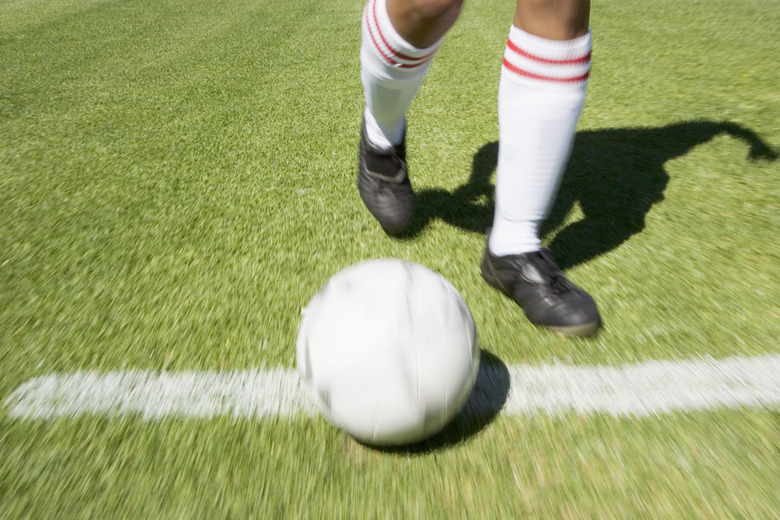Science Fair Projects Involving A Soccer Ball
Science fair projects can be a drag for some students. Incorporate something that they're interested in, such as sports, to make the project less of a chore and more interesting. A soccer ball can become a part of science project through studying the way that it bounces on different surfaces, air pressure experiments, velocity and trajectory.
Surface Effect
Surface Effect
A science fair project based on the effects of different types of turf on the bounciness of a soccer ball studies the physics and energy of the ball. Find three types of turf where you can perform your experiment. Select a field that's planted with Kentucky bluegrass, one with Bermuda grass and one that has artificial turf. Write a hypothesis as to which turf you think the ball will be the bounciest on. You will need to consider the energy of your ball when forming your hypothesis. You will be dropping your ball from six feet above the turf. When the ball drops, the potential energy converts to kinetic energy. After the ball hits the turf, the ball deforms upon impact. This converts the kinetic energy to compressed potential energy. When the air decompresses after impact, the potential energy will be converted to kinetic energy when the ball bounces upwards. Bring a friend with you to help with your testing. Have your friend climb on top of a ladder and drop the ball from six feet in the air. Count how many times the ball bounces on each type of turf. Drop the ball ten times at each field and use the average number of bounces of each field in your analysis. Write an account of your experiment for your project. Graph the data on a bar chart to show each type of field. Write a conclusion comparing your hypothesis to the results of the experiment.
Air Pressure
Air Pressure
Study the relationship between air pressure and how far a soccer ball travels. Write a hypothesis with your opinion of what the optimum air pressure for a soccer ball is. The air pressure affects the ball because of the number of air molecules inside. When there are more air molecules inside the ball, the tension on the wall of the ball increases. This will cause the ball to bounce harder and affect the way the ball travels after hitting a surface. Build a slingshot or use a water balloon launcher to test the distance of the ball. Put two pounds of pressure in the ball and launch it with the slingshot. Measure how far the ball travels. Perform the experiment two more times by launching the ball from the same place. Repeat the test again by adding two more pounds of air pressure to the ball. Increase the pressure each time by two pounds until you get to twelve. Write an explanation of your experience including how far you pulled the ball back in the slingshot. Compare the distances of the ball to determine the optimum air pressure for performance. Show your results on a line graph. Write a conclusion evaluating your hypothesis in regards to the conclusion of your experiment.
Stitching
Stitching
Experiment with how the stitching of a soccer ball can affect the distance it travels. Write a hypothesis stating which ball you think will travel the farthest. The way the ball is stretched and stitched together along with the material makeup of the ball can affect the shape of the ball and the way it compresses the air inside. Even though all of the balls look round, there could be slight differences in them due to the amount of panels and stitches it took to make it. Bring a friend with you to the soccer field along with four soccer balls. Each soccer ball will have varied amounts of panels on the exterior, usually anywhere between 12 and 32. Have your friend kick each ball ten times using the same force. Measure how far the ball travels and take the average distance for each ball. Explain in your project your experiment and how you executed it. Compare the distances on a line graph and determine whether or not the panels affect the ball's velocity. State in your conclusion whether the ball you chose in your hypothesis matched up with the results of the experiment.
Spin
Spin
Investigate the relationship between spin and trajectory of the soccer ball. When a ball is kicked straight on with the instep of your foot, it travels straight. If you kick the ball with the toe of your shoe at an angle, the ball can curve in flight from the applied force. The applied force acts as torque and causes the ball to spin. Select which angle you think will curve the ball the most and state it as your hypothesis. Take a video camera to the field with you. Set up the video camera on a tripod to record your experiment. Explore how you strike the ball with your foot in specific spots and how it spins the ball. Examine on the video where you struck the ball with your foot and the resulting path of the ball. Write an account of your experiment. Analyze the kick angles, point of impact and path of the ball by sketching them on a drawing. Use a different color ink for each kick on the drawing to show where each ball travelled. Write a conclusion comparing your hypothesis to the results of the trial.
Cite This Article
MLA
Baldwin, Caroline. "Science Fair Projects Involving A Soccer Ball" sciencing.com, https://www.sciencing.com/science-fair-projects-involving-soccer-ball-12207633/. 24 April 2017.
APA
Baldwin, Caroline. (2017, April 24). Science Fair Projects Involving A Soccer Ball. sciencing.com. Retrieved from https://www.sciencing.com/science-fair-projects-involving-soccer-ball-12207633/
Chicago
Baldwin, Caroline. Science Fair Projects Involving A Soccer Ball last modified August 30, 2022. https://www.sciencing.com/science-fair-projects-involving-soccer-ball-12207633/
